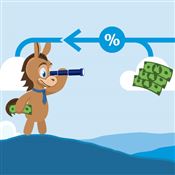ROI Calculator
Want to evaluate the performance of your investment? Use this ROI calculator to see how much your investment earned (or lost).
 |
ROI is a simple, helpful metric to assess how profitable an investment is.
So how do you calculate ROI?
With this calculator, you'll know the:
- ROI of your investment
- Annualized ROI of the investment
- Total loss or profit your investment generated
Find out how ROI is calculated, the pros and cons of using ROI, and tips for making smart investments in this guide.
What is ROI?
ROI, or Return on Investment, is a metric people use to evaluate the efficiency of an investment. It compares the returns earned to the initial cost of the investment.
If an investment has a high ROI, it typically means it earned enough to make the initial investment worth it. If an investment has a low or negative ROI, the initial cost may outweigh any returns earned.
ROI can be used to calculate returns already earned, or it can be used to predict the returns your investment will earn.
How do you calculate ROI?
The easiest way to calculate ROI is by this formula:
ROI = (Final Value - Initial Value) / Cost of Investment
- Final Value = How much your investment is worth by the end?
- Initial Value = How much your investment was worth when you first bought it?
- Cost of Investment = How much you spent in total on the investment (including fees you paid)?
- First, find the profit of your investment by subtracting the initial value from its current value.
- Then, divide the profit amount by the total cost of the investment.
- That is your ROI.
For example, let's say you invested $25,000 in a piece of crowdfunded real estate. 5 years later, it's sold and your share is worth $35,000. In total over the years, you've spent $2,000 in platform fees.
Your ROI will look like:
($35,000 - $25,000) / ($25,000 + $2,000) = 0.37 or 37%
Cumulative vs Annualized ROI
Our ROI calculator also tells you the annualized ROI. This is different from the total ROI.
- Cumulative ROI calculates investment performance over the entire investment period.
- Annualized ROI is the return of an investment on an annual basis. This takes compounding into consideration.
Knowing the annualized ROI is helpful when comparing different investments.
For example, let's say you plan to invest $10,000 each into Investments A and B. Investment A is expected to be worth $15,000 after 5 years. Investment B is expected to be worth $13,000 after 3 years. Which is better?
With the ROI calculator, we find that A has an annualized return of 8.45%. B has an annualized return of 9.14%. So Investment B has the stronger ROI.
What is a good ROI?
Well there's no single number that's considered a good ROI, it's commonly thought that an annualized return of 8%-10% is good for long-term investments. This is on par with the S&P average.
But every situation is different. A good ROI will depend on many other factors than just the returns and the initial investment cost.
These factors may include your risk tolerance, investment timeline, the specific industry or type of investment, and more.
A low ROI to one investor could be considered a high ROI to another. For example, those nearing retirement will most likely seek investments with lower but steady returns.
Pros and Cons of ROI
ROI can be a helpful metric, but it shouldn't be the only number you look at. Here are some pros and cons to keep in mind when using ROI to assess your investment.
Pros
- Easy to calculate
- Easy to understand
- Can help you decide if an investment is worth it
- An easy way to compare investments
Cons
- Doesn't typically consider holding period
- Doesn't take risk into account
- Doesn't take inflation into account
- Can be inflated if all costs aren't considered
- Only calculates financial gains, not any other benefit
As you can see, while ROI is a simple, handy metric, there are better ways to evaluate your investments. Find a few smart ideas for getting the most out of your investments with the tips below.
Tips for Making Smart Investments
Calculating the ROI can be helpful in evaluating whether your investments are worth the cost and time. Here are a few other ways to keep tabs on your investments:
- Make sure your finances are stable, first. That means having a healthy emergency fund, paying down any high-interest debt, and having a solid retirement plan in place.
If you have a lot of high-interest debt, a personal loan may be a decent option to pay it down before diving into investing. Just make sure you can secure an affordable rate (less than 10%, ideally 7% or lower.)
- Use a portfolio analyzer. Portfolio analyzers give you in-depth information and tools about all your investments, including your returns over time. Portfolio management software is another good tool for monitoring performance (and many are free).
- Use other metrics to measure your investments. Try calculating net present value to see the value of a potential investment or a standard investment calculator to estimate potential growth.
- Consider outside advice or opinions. Ultimately, you'll know what investments are best for you. But, hearing thoughts from other voices in the investing world can be a good way to expand your point of view.
Just remember to take everything you read or hear with a grain of salt! One person's situation will likely be wildly different than your own.
Bottom Line
Whatever you might be investing in, calculating ROI is a helpful, easy way to evaluate performance. Just remember that it's not the end-all-be-all of investing metrics. There are many more factors to consider.
When calculating ROI, keep in mind that what's considered "good" or "bad" will depend on many things, like your risk tolerance, timeline, the type of investment, and much more. Do as much research as you can to get the full picture of whether the investment is worth it.
Holly Zorbas is a assistant editor at CreditDonkey, a personal finance comparison and reviews website. Write to Holly Zorbas at holly.zorbas@creditdonkey.com. Follow us on Twitter and Facebook for our latest posts.
|
|
| ||||||
|
|
|







